Search Results for Tag: ice
Arctic investment: still a hot prospect?
As I mentioned in the last post, I talked to various people about the current state of interest in the Arctic, in connection with the ArcticNet conference on “Arctic Change” in Ottawa last week. I would like to share some of the insights I gained with you here on the Ice Blog. With a lot of concerned people still suffering from a kind of mental hangover after the two weeks of UN climate negotiations in Lima, let me also direct you to a commentary I wrote for DW: Lima: a disappointment, but not a surprise. If you expected any action at the meeting which might help stop the Arctic warming, you will have been highly disappointed. If, like me, you think the transition to renewables and emissions reductions we need have to happen outside of and alongside that process, all day and every day, your expectations will not have been so high.
But back to the Arctic itself. With Canada coming to the end of its spell at the helm of the Arctic Council and preparing to hand over the rotating presidency to the USA at the end of the year, the annual conference organized by the research network ArcticNet was bound to attract a lot of interest. More than 1200 leading international Arctic researchers, indigenous leaders, policy makers, NGOs and business people attended the Ottawa gathering to discuss the pressing issues facing the warming Arctic.
Hugues Lantuit from Germany’s Alfred Wegener Institute is a member of the steering committee. He’s an expert on permafrost and coastal erosion. He told me in an interview that the region had to prepare for greater impacts ,with the latest IPCC report projecting the Arctic would continue to warm at a rate faster than any place on earth. While the retreat of sea ice allows easier access for shipping and more scope for commercial activities, Lantuit is concerned about the thawing of permafrost, a key topic at the Ottawa gathering:
“An extensive part of the circumpolar north is covered with permafrost, and it’s currently warming at a fast pace. A lot of cities are built on permafrost, and the layer that is thawing in the summer is expanding and getting deeper and deeper, which threatens infrastructure.”
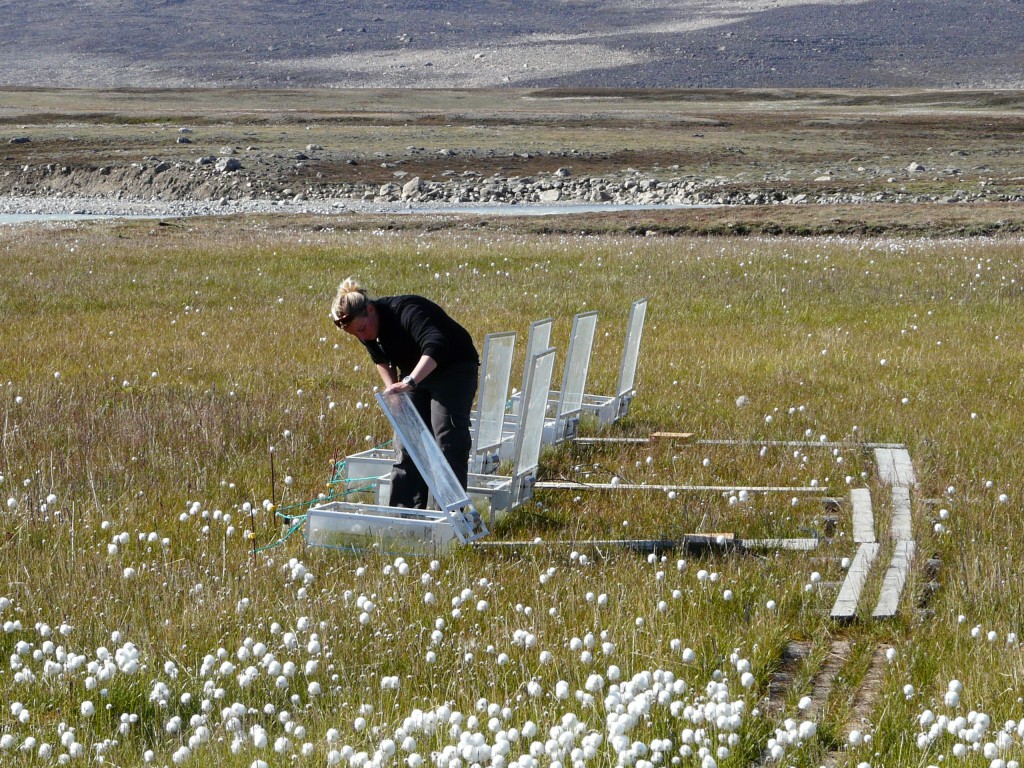
Scientists at measuring stations like the one I viisted at Zackenberg, Greenland, measure the amount of greenhouse gases emitted by melting permafrost. (I.Quaile)
Northern communities worried
Residents of northern communities are concerned about the impact of melting permafrost on railways, landing strips and buildings. Lantuit and his colleagues have created an integrated data base for permafrost temperature, with support from the EU. At the Ottawa meeting, he and his colleagues worked on identifying priorities for research, taking into account the needs of communities and stakeholders in the Arctic.
Another key issue on the Ottawa agenda was coastal erosion. Sea ice acts as a protective barrier to the coast, preventing waves from battering the shore and speeding up the thaw of permafrost. With decreasing sea ice in the summer, scientists expect more storms will impact on the coasts of the Arctic. “In some locations, especially in Alaska, we see much greater erosion than there was before”, says Lantuit. This creates a lot of issues: “There is oil and gas infrastructure on the coast, villages, people, also freshwater habitats for migrating caribou, so the coast has a tremendous social and ecological value in the Arctic, and coastal erosion is obviously a threat to settlements and to the features of this social and economical presence in the Arctic.”
Bad news for furred and feathered friends
Amongst the participants at the conference was George Divoky, an ornithologist who has spent every summer of the past 45 years on Cooper Island, off the coast of Barrow, in Arctic Alaska. Divoky monitors a colony of black guillemots that nest on the island in summer. His bird-watching project turned into a climate change observation project as he witnessed major changes in the last four decades:
“Warming first aided the guillemots (1970s and 1980) as the summer snow-free period increased. The size of the breeding colony increased during the initial stages of warming. Continued warming (1990s to present) caused the sea ice to rapidly retreat in July and August when guillemots are feeding nestlings, and the loss of ice reduced the amount and quality of prey resulting in widespread starvation of nestlings.”
The 2014 breeding season on Cooper Island had the lowest number of breeding pairs of Black Guillemots on the island in the last 20 years, Divoky says. Reduced sea ice is increasingly forcing polar bears to seek refuge on the island, eating large numbers of nestlings. Polar bears were rare visitors to the island until 2002.
The Arctic and the global climate
Divoky went to Ottawa to fit his research and experience into the wider context of climate impacts in the Arctic. Researching climate change and its effects are important but of little practical use if the research does not inform government officials and result in policies that address the causes of climate change, Divoky argues.
I asked Hugues Lantuit whether he thought the UN climate conference in Peru could achieve anything that would halt the warming of the Arctic. He said reducing emissions and reducing temperature were the only way to reduce the thaw of permafrost. But he is quite clear about the fact that there is no mitigation strategy in terms of permafrost directly. “You would have to put a blanket over the entire permafrost in the northern hemisphere. This is not possible.”
At the same time, he stressed the key role of the Arctic with regard to the whole world climate: “Permafrost contains a lot of what we call organic carbon, and that is stored in the upper part. And if that warms, the carbon is made available to microorganisms that convert it back to carbon dioxide and methane. And we estimate right now that there is twice as much organic carbon in permafrost as there is in the atmosphere”.
So far, the international community has not been able to take measures to break that vicious circle.
What happened to the Arctic gold rush?
Communities who live and companies that work in the Arctic have to focus on adaptation to the rapid change, says Lantuit. In his eyes, economic activity is increasing, posing new challenges for infrastructure and the environment.
Malte Humpert, the Executive Director of the Arctic Institute, a non-profit think tank based in Washington DC has a different view on the matter. He says while attendance at Arctic conferences and interest in the Arctic is still high, commercial activity has actually been cooling off. “We are seeing a slow-down of investment. Up to this point there has been a lot of studying, a lot of interest being voiced, with representatives from China or South Korea, Japan, Singapore or other actors, arriving at conferences, speaking about grand plans. But up to this point a lot of the talk has been just that.” A lot of activity has been put on hold, says Humpert. He says the “gold rush mentality we saw a few years ago” has weakened. “There was a lot of talk about Arctic shipping initially, then we had oil and gas activity in 2012, north of Alaska, then we had the discussion about minerals in Greenland. The question is now, with the oil price being down below 70$ a barrel, some political uncertainties over the Ukraine, involving the EU and Russia, how will that affect Arctic development?”
Humpert stresses the Arctic does not exist in a vacuum, but has to be seen within the global context. Sanctions on Russia because of the Ukraine crisis have created economic problems for Moscow and limited access to technology it might need for its Arctic activities. “Maybe Arctic development has been oversold and overplayed and will be more of a niche operators’ investment. One could definitely question if there will be this global push into the Arctic.”
Arctic development on ice
Humpert is skeptical that any major development will take place before 2030. He says developing the infrastructure in terms of ports and communications in the remote Arctic region would require billions of dollars of investment, and would have to be a very long-term proposition. It will also depend to a large extent on exactly how climate change affects ice conditions in the Arctic. Climate change can make the climatic conditions in the Arctic more variable. This means that for a temporary period, there might even be more ice, which would block transport routes.
The Arctic Institute says there has actually been a slow down this year in terms of navigation on the northern sea route (NSR) in particular: “The season just closed about a week ago. Last year we had 1.35 million tonnes of cargo being transported along the NSR, this year we had less than 700,000 tonnes, so an almost 50% decrease, just because there was more ice in the way”, says Humpert.
Whether slower development is good news or bad depends on your perspective. The lull in Arctic activity could pre-empt environmental degradation or destruction, says Humpert, and leave scope to consider development of the Arctic in what he calls a 21st century way. Instead of “old-school” thinking about extracting minerals, oil and gas and increasing shipping, there could be a focus on bringing modern, high-speed communications, fiber optics and thinking about renewables, such as wave energy. This would benefit the small populations in the Arctic, the expert argues.
But from the viewpoint of a country like Russia, he adds, where 40 percent of your exports are generated above the Arctic circle, in terms of hydrocarbon resources, the slowdown in Arctic development because of the drop in oil prices and political tensions over Ukraine is very worrying.
So while these developments seem to have brought the Arctic a breathing space, ultimately, the commercialization of the region could be just a matter of time. Ottawa conference organizer Lantuit argues that there has always been activity in the high North. The priority now, he says, must be to ensure international cooperation and additional investment in protecting the environment and maintaining safety in a region where rapid change seems to have become the status quo.
Thick Antarctic ice not sign of cooling
The recent publication of a study on Arctic ice as measured by the “yellow submarine”, an underwater robot, caused a flurry of comments on the “climate hoax” by some of those of a “climate-sceptical” persuasion. I contacted a sea ice physicist at Germany’s AWI Institute for an independent opinion. Here’s the background:
Measurements conducted by an underwater robot have found that Antarctic sea ice is much thicker than previously thought in some places. Much of this floating sea ice is underwater, hidden from the satellites which have been tracking seasonal sea ice for decades. The satellite data is normally validated by drilling into ice floes which can be reached by ship, or visual estimates from the ships themselves. However, it is difficult to reach the thickest ice that way.
Underwater robot below the ice
Over the last four years, an international group of researchers has been mapping the bottom of sea ice in several areas of the Antarctic using an underwater robot, or AUV. It can swim to a depth of some 30 metres (100 feet) and uses sonar directed upwards to survey the bottom of the sea ice. This gave them access to areas where measurements could not be carried out until now.
The study, published in the journal Nature Geoscience, suggests that the average ice thickness could be considerably higher than previous estimates. In three regions surveyed, the robot sub found that deformed, thickened ice accounted for at least half of and as much as 76 percent of the total ice volume, the researchers say.
Climate skepticism vindicated?
While Antarctica’s ice sheet, that is the land ice, is melting and retreating, the extent of the sea ice has been expanding over the last three winters. This has led some who are skeptical about climate change to suggest that it could be evidence that human-made global warming is not happening. But sea-ice physicist Stefan Hendricks, from the Alfred-Wegener Institute for Polar and Marine Research, based in Bremerhaven, Germany, told me in an interview the new measurements were no reason to doubt climate change is happening.
“What our colleagues have shown is that ship-based measurements do not record this really thick ice. That is no surprise to us. It is good that they have found this out, but basically it just tells us that we have to be cautious when it comes to using ship-based data”, Hendricks said.
The sea ice extent in the Antarctic has been growing, while the sea ice in the Arctic, at the northern end of the planet, has decreased dramatically in recent years. Hendricks stresses that the two regions are completely different:
“The Arctic Ocean is surrounded by land, whereas in the Antarctic, the land is in the middle. If the Arctic were not surrounded by land, the ice cover would also be much bigger in winter”, says Hendricks. The increase in Antarctic sea ice in winter can be partly explained by the wind direction, he adds . Ice grows faster, the thinner it is. If it is blown out from shore, for instance into the Indian Ocean, new ice is created very quickly, according to the ice expert. He also warns against comparing what happens to the Arctic in summer to what happens at the southern end of the planet in winter:
“If you look at the cycle over the whole year, your will see that the sea ice in the Antarctic also melts almost completely in summer”.
Valuable data, limited application
Still, the German expert says the new ice measurements from the Antarctic are of major importance to our understanding of how sea ice behaves. But he stresses that the ice floes are on the move all the time. Although the measurements are very exact, the situation is constantly changing ,and the measurements could only be taken at a limited number of spots in what is a huge area of ice.
“The question is how representative is this for the total ice extent? This depends to a very large extent on which ice floe you take. There are large differences between them. The differences are particularly marked if you go further away from land. Close to land, the ice piles up and is deformed and so you get this very thick ice. Further out, you don’t get that”.
The new measurements certainly do not give any reason to be more relaxed about climate warming, says Hendricks. Increased sea ice could have a cooling effect, as ice reflects heat back into space, whereas the sea water absorbs the heat, exacerbating warming. But given that the ice melts again in summer, that effect would be very slight, says the physicist.
Arctic icon in decline
As I plan my coverage of this year’s annual UN climate conference, this time in Peru, a news item from WWF pops up in my mail box. The organization is concerned that the number of polar bears in the Beaufort See in Alaska and in north-western Canada has dropped by around 40 percent in the last ten years. Now that is a very worrying statistic.
It is based on a study published in the journal Ecological Applications: Polar bear population dynamics in the southern Beaufort Sea during a period of sea ice decline.
In 2004, it seems 1,500 polar bears were counted. The latest count showed just 900. Declining sea ice and a lack of prey seem to be the likeliest causes. Another piece of evidence to justify the decision in 2008 to list polar bears under the US Endangered Species Act.
WWF fears the worrying trend will continue if climate change is not halted. There are only between 20,000 and 25,000 polar bears left in the world. With the average air temperature in the Arctic a good five degrees centigrade higher than it was a hundred years ago, it is hardly surprising that nature is struggling to cope. As the sea ice declines, the bears are losing their habitat. You might also remember the pictures of all those walruses on the beach a few weeks ago. They too, were affected by the decline of the sea ice where they usually rest between dives.
So what can we do to halt the decline in the polar bear population? This brings me back to the forthcoming climate conference in Peru. I am finding it difficult to arouse interest in this year’s meeting. “Paris next year is the important one”, I hear. So does climate action just get put on hold for another 12 months? Tell that to the polar bears. One single conference cannot save the world from the climate catastrophes that could lie ahead if the world does not manage to reduce its emissions drastically in the next few years. UNEP’s “Emissions Gap Report 2014”, just published yesterday, says we have to be carbon-neutral by the 2nd half of this century to keep temperature rise below two degrees centigrade. There is still a huge gap between the pledges made by countries within the UNFCCC framework and what is necessary for that. Emissions would have to peak within the next ten years, says the UNEP report, based on the latest IPCC data. Otherwise we risk severe and irreversible climate change with all the droughts, floods and other impacts that come with it.
Given the need for urgent action, I fail to understand how anyone can say “forget Peru, wait for Paris”. I would be the first to stress that these conferences alone cannot halt climate change. The switch to renewable energy is already underway. But ultimately, governments have to agree to binding targets. We have seen encouraging signs from the top emitters China and the USA. Without those international negotiations, this is unlikely to have happened. Let us take the Peru conference as an opportunity to focus world interest on the urgency of climate action. Countries have to keep doing there homework. I don’t know if we will be able to turn our energy policies around in time to save the bears. But if they are to have any chance – at the risk of sounding clichéd: the time for action is now, and any major climate event is a chance to say so.
The Arctic on the UN agenda
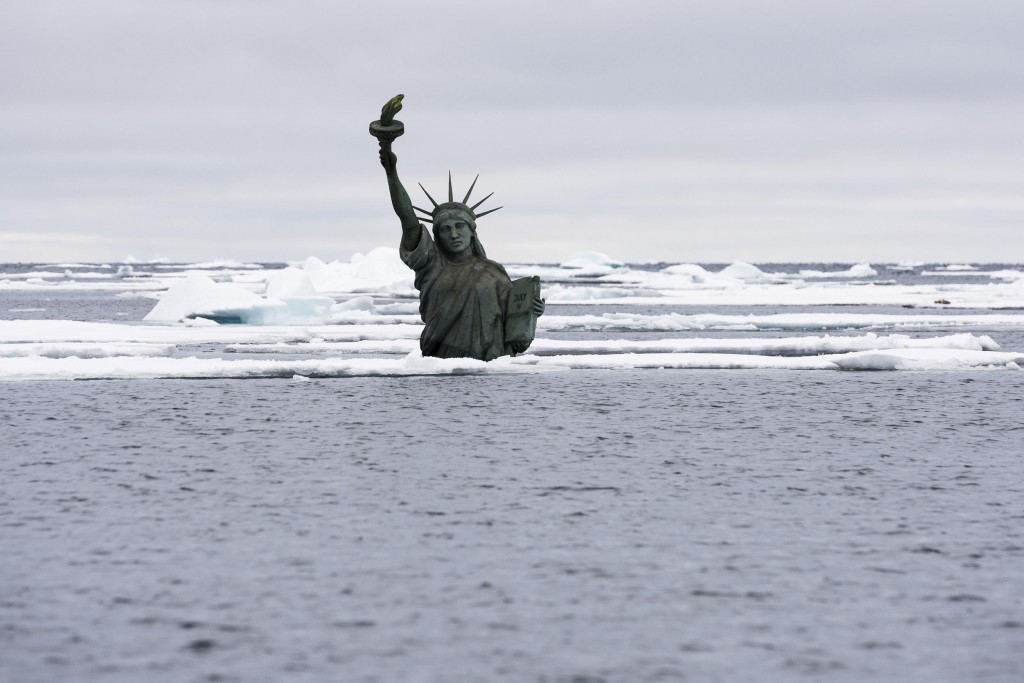
US icon sinking in melting ice? The photo was taken in the Arctic Ocean northwest of Svalbard the 7th of September 2014.
(Christian Auslund / Greenpeace)
To those of us who deal with the Arctic on a regular basis, the significance of the melting ice for the UN climate negotiations and vice versa is abundantly clear. But not everybody understands all the connections. A major media event like this week’s New York climate summit hosted by the UN Secretary General Ban Ki Moon in person was a fine chance to focus attention on the need to protect the Arctic. Greenpeace made good use of it, handing over a petition with six million signatures just ahead of the big event, and with hundreds of thousands gathered in New York for the Climate March.
It was timely in more ways than one, just as the latest sea ice figures were published to confirm the melting trend.
The petition calls for long-term protection of the Arctic, with the region warming more than twice as fast as the global average and opening the high north to shipping and commercial exploitation. Greenpeace and other groups are calling for a ban on oil exploration, which could endanger the fragile ecosystem. Experts also have safety concerns about increased shipping.
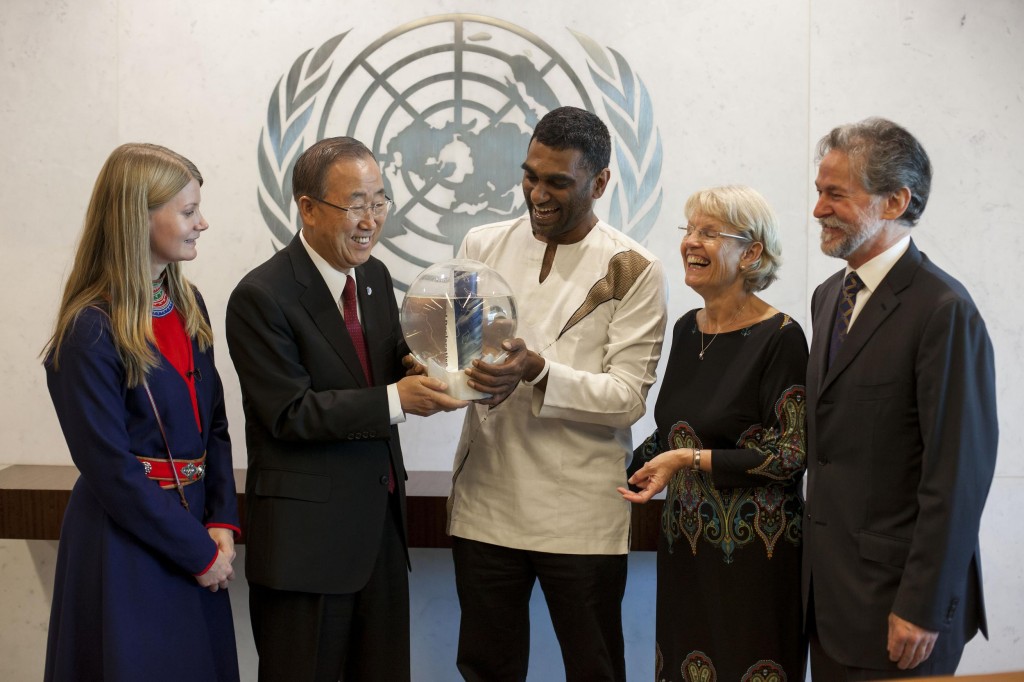
Ban Ki-moon receives the Greenpeace delegation with the petition. The delegation consists of Indigenous rights activist, youth leader and Saami politician Josefina Skerk, Margareta Malmgren-Koller, Greenpeace Senior Political Advisor Neil Hamilton and Greenpeace International Executive Director Kumi Naidoo. Photo: Michael Nagle / Greenpeace
Commercial development versus environment
Earlier this month, a survey showed that 74% of people in 30 countries support the creation of a protected Arctic Sanctuary in the international waters surrounding the North Pole. The study was commissioned by Greenpeace and carried out by Canadian company, RIWI. Around the same time, the Arctic Council, which combines the Arctic states and indigenous peoples’ representatives, currently chaired by Canada, supported the founding of a new business grouping, the Arctic Economic Council. Its aim is to promote the commercial development of the Arctic region. I wrote about this here on the Ice Blog and on the DW website.
Global responsibility for the Arctic
The UN Secretary General accepted the Greenpeace petition saying:
“I receive this as a common commitment toward our common future, protecting our environment, not only in the Arctic, but all over the world.”
Ban Ki-moon said he would consider convening an international summit to discuss the issue of Arctic protection. He also expressed a desire to travel aboard one of the organisation’s campaigning ships in the Arctic in the near future.
Greenpeace Executive Director Kumi Naidoo, who was part of the delegation, said: “The Arctic represents a defining test for those attending the summit in New York”.
He said leaders should bear in mind that concern for the rapid warming of the world was not consistent with planning oil and gas development in the melting Arctic.
The small delegation that met Ban Ki Moon included Indigenous rights activist and Saami politician Josefina Skerk, who last year trekked to the North Pole to declare the top of the world ‘the common heritage of everyone on earth’.
Skerk, a member of the Saami Parliament, said: “We, who want to continue living in the North, are gravely concerned about climate change and the destructive industries that are closing in. My people know and understand the Arctic, and it is changing in a manner, which threatens not just our survival, but the survival of people all over the world.”
Skerk said humans had created the crisis and had to take action to solve it.
“I urge the Arctic countries in particular to take a giant step up and I think the world needs to pay much closer attention to ensure that it happens. They might as well start here in New York.”
From Kiribati to Svalbard and New York
Melting ice especially from the Arctic Greenland ice sheet is raising sea levels around the globe, endangering low-lying areas. At the weekend, the President of Kiribati, Anote Tong, ended a Greenpeace-organized tour of glaciers in Norway’s Svalbard Archipelago. He said the trip to the Arctic ice had made a deep impression on him, which he would share with world leaders at the U.N. climate summit:
“It’s a very fascinating sight. In spite of that, what I feel very deeply is the sense of threat,” Tong said. “If all of that ice would disappear, it would end up eroding our shores.”
Kiribati is a group of 33 coral atolls located about halfway between Hawaii and Australia. Many of its atolls rise just a few feet above sea level.
In last year’s report by the Intergovernmental Panel on Climate Change (IPCC), experts concluded oceans could rise by as much as 1 meter (3.3 feet) by the end of this century if no action is taken to cut the greenhouse gas emissions causing global warming.
“It won’t take a lot of sea level rise to affect our islands,” Tong said. “We are already having problems.”
Sea ice minimum confirms melting trend
The New York summit coincides with the annual announcement of the minimum sea ice for the year, as the summer season comes to an end. The sea ice – in contrast to glaciers on land – does not influence global sea level, but is regarded as a key indicator of how climate change is affecting the region. This year the figure announced by the US National Snow and Ice Data Centre (NSIDC) was 5.01 million square kilometers. The figure is the sixth lowest extent since records began.
The minimum ever recorded at the North Pole was 3.29m sq km in 2012 – and the eight lowest years have been the last eight years.
Ice levels in the Arctic have recovered from their all-time low, but are still on a shrinking trend, said Julienne Stroeve of the National Snow and Ice Data Centre. ”We have been telling this story for a long time, and we are still telling it,” she said.
NSIDC records showed that, this year, ice momentarily dipped below 5million sq km to 4.98m on 16 September, but the official figure is taken from a five day average.
Satellite data shows that one part of the Laptev Sea was completely clear from sea ice for the first time this summer. One of the most important questions for climate scientists is how soon the Arctic will experience its first sea ice-free summer.
Rod Downie, head of WWF UK’s polar programme, said that this year’s new Arctic minimum should prompt new action from the leaders meeting in New York. He stressed the connection between the Arctic and weather conditions in other parts of the world:
“As David Cameron prepares to meet other global leaders at the UN climate change summit in New York, the increased frequency of extreme weather that is predicted for the UK as a result of a warming Arctic should serve as a reminder that we need urgent action now to tackle climate change,” he said.
The summit was a major PR event to draw attention to the need for urgent and substantial climate action. The accompanying protests around the globe show people are not happy with the slow pace of the climate talks and their governments’ efforts to reduce emissions. Of course there was little in the way of concrete pledges. Still, on the whole, I see it as a successful step on the way to a new climate agreement because it has put the spotlight on climate change at a time where international conflicts are dominating the news agenda.
More commentary on the summit from me here:
World leaders must act as climate takes centre stage
All-star gala puts climate back on the agenda
Arctic Economic Council – and the environment?
I would like to share my thoughts with you on the founding meeting of the Arctic Economic Council, taking place in Canada Sept. 2nd and 3rd. Iqaluit, the capital of the northern Canadian territory of Nunavut, is hosting the inaugural meeting of the, group set up to promote commercial development in the Arctic, as climate change makes the region more accessible. It was in Iqaluit that the first-ever ministerial meeting of the Arctic Council (AC) took place back in 1998. The newly established independent Arctic Economic Council (AEC), with close links to the AC, could prove to be equally influential.
Canada currently holds the rotating presidency of the Arctic Council, an organization linking eight Arctic states and six organizations representing Arctic indigenous peoples. Its self-set tasks include sustainable development, monitoring the Arctic environment, identifying pollution risks and environmental emergency preparedness. But in the race to open the Arctic to increased shipping, oil and gas exploration and mining, the formation of the new Arctic Economic Council (AEC) could see commercial interests gaining the upper hand.
Canada puts business first
Leona Aglukkaq, Canada’s Minister for the Environment, the Canadian Northern Economic Development Agency and the Arctic Council, is presiding over the founding meeting of the AEC. Its creation has been a key project during Canada’s 2013-2015 Arctic Council chairmanship, which Aglukkaq has focused on “development for the people of the North.”
“Our government prioritized the creation of the Arctic Economic Council to facilitate business opportunities, trade, investment and growth in the best interests of Northerners,” said Aglukkaq ahead of the two-day meeting. “Establishing this body is an historic moment for the Arctic Council in its efforts to advance sustainable development in the Arctic. I’m confident that the AEC will be a strong and effective body that will help enhance pan-Arctic economic cooperation for the benefit of communities and people in the Arctic.”
An unwise move for the AC?
But some people believe the AC could be making a mistake by allowing a potentially highly influential business group to grow outside of its own structures. Neil Hamilton, Senior Polar Political Advisor at Greenpeace International, told DW: “By creating an independent organization which answers to no one but has the authority to attend, work within, and manipulate the activities of the Arctic Council and its working Groups, the Arctic Council has severely undermined its own mandate.”
The AEC is being established with the contribution of the Arctic Council, but as an independent body. Representatives of both Councils would meet at regular intervals to discuss the economic development of the Arctic.
Originally, the AEC was envisaged as a circumpolar business forum. It’s since turned into a more formal structure. Each of the member states and each of the council’s indigenous permanent participant organizations was invited to send a maximum of three representatives to the inaugural meeting, where they will discuss the organization, structure and objectives of the AEC. The business representatives attending include CEOs and other high-ranking figures from a range of industries including oil and gas exploration, iron mining, tourism and shipping lines.
In the future, membership will not be limited to these nominations and may accept self-nominations from the Arctic business community.
A back-seat for the environment?
Canada says businesses in the Arctic will play a strong role in building a sustainable and economically vibrant future for the region. This will not reassure environment campaigners who have repeatedly attacked the current Canadian administration for its support of environmentally problematic industries such as oil tar sands or fracking, and for its refusal to back international climate agreements. The participation of the Vice-President of Russia’s Rosneft Oil Company Andrey Shishkin will raise eyebrows among those concerned about the possible environmental impact of oil exploration in the High North.
Finland is seeking to chair the AEC, although the group is to be purely business and not government run. In a press release, the country’s Foreign Ministry mentions environment protection but does not appear to give it priority when it outlines the objectives of the new body:
“In the future, the main focus of its work will be on the enhancement of the economic operating conditions of indigenous peoples and Small and Medium Enterprises (SMEs), the reduction of obstacles to trade, the support for sustainable economic operations, and raising of issues the AEC itself considers topical.”
In an AC paper on “facilitating the creation of the Arctic Economic Council,” environmental protection is only listed the last of six objectives, in connection with “maximizing the potential for Arctic economic activities.”
Conservationists are concerned that protecting the environment could take a back seat while companies pressure for fewer restrictions. With the Arctic warming more than twice as fast as the rest of the world and melting ice easing access to northern regions, the pace of Arctic development could outrun efforts to ensure environment protection and safety measures with increasing shipping and the risk of accidents or oil spills.
The World Wildlife Fund, which originally supported the group, told journalists the way it had been set up was “opaque and unaccountable”. WWF said it hat been refused permission to observe the meeting.
Greenpeace Arctic policy advisor Hamilton told DW: “The founding document of the Arctic Economic Council sets the frame for a new era of exploitation of the Arctic, without any indication of intent to protect the environment.” At the same time the Arctic Council, which was established to protect the environment, was “negating its prime function.”
Hamilton called on the Arctic Council to accord civil society the same privilege as it appears to be allowing the new economic group, by loosening regulations on granting the role of observer status.
The two-day meeting in Iqaluit ends on Wednesday, September 3rd. In the coming months, the Arctic Council will have to clarify its relation to the new AEC it helped create, and demonstrate how it’s going to reconcile the increasing pressure for commercial activity with avoiding environmental damage.



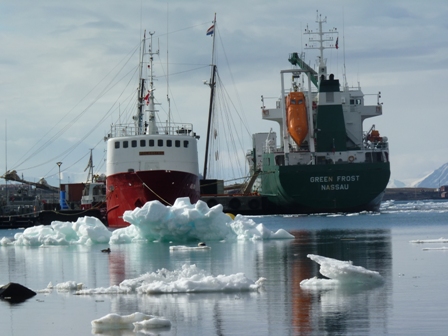

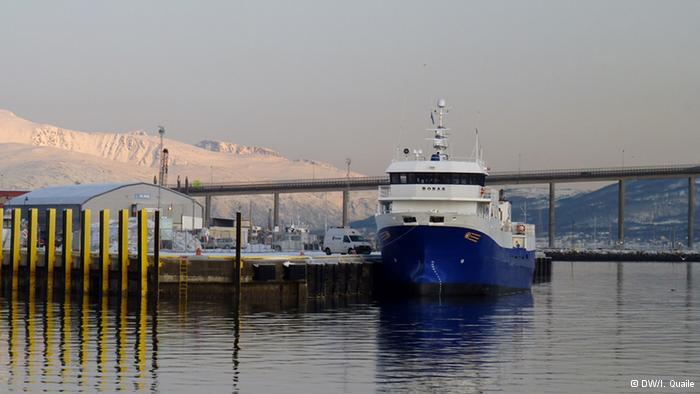

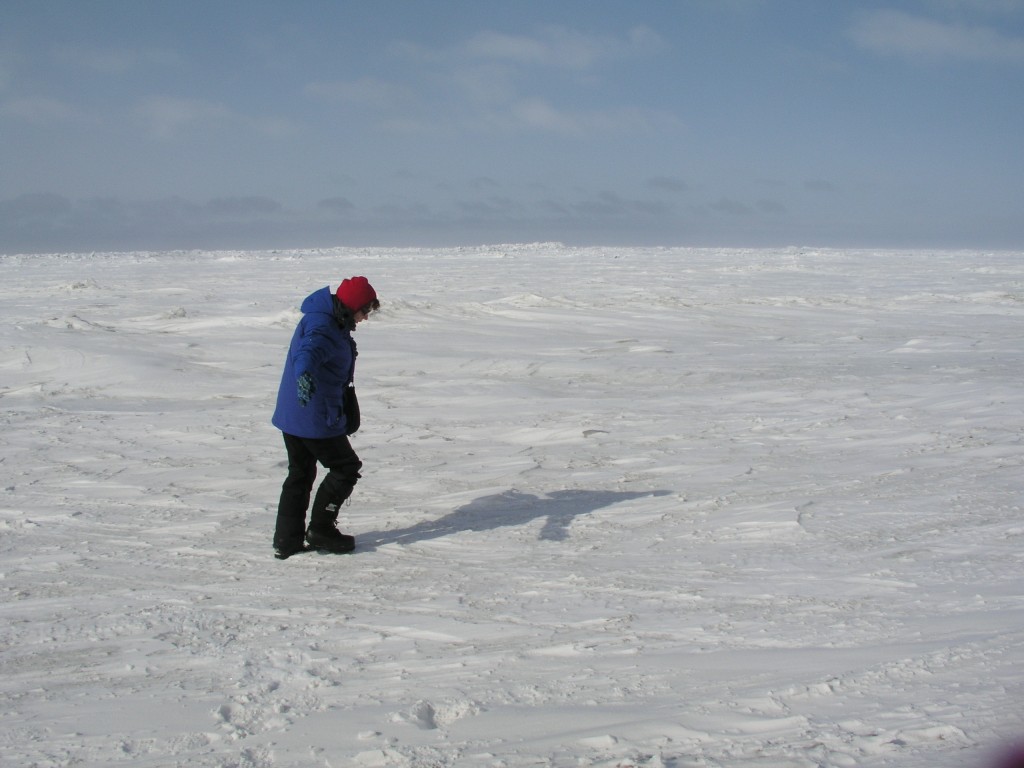
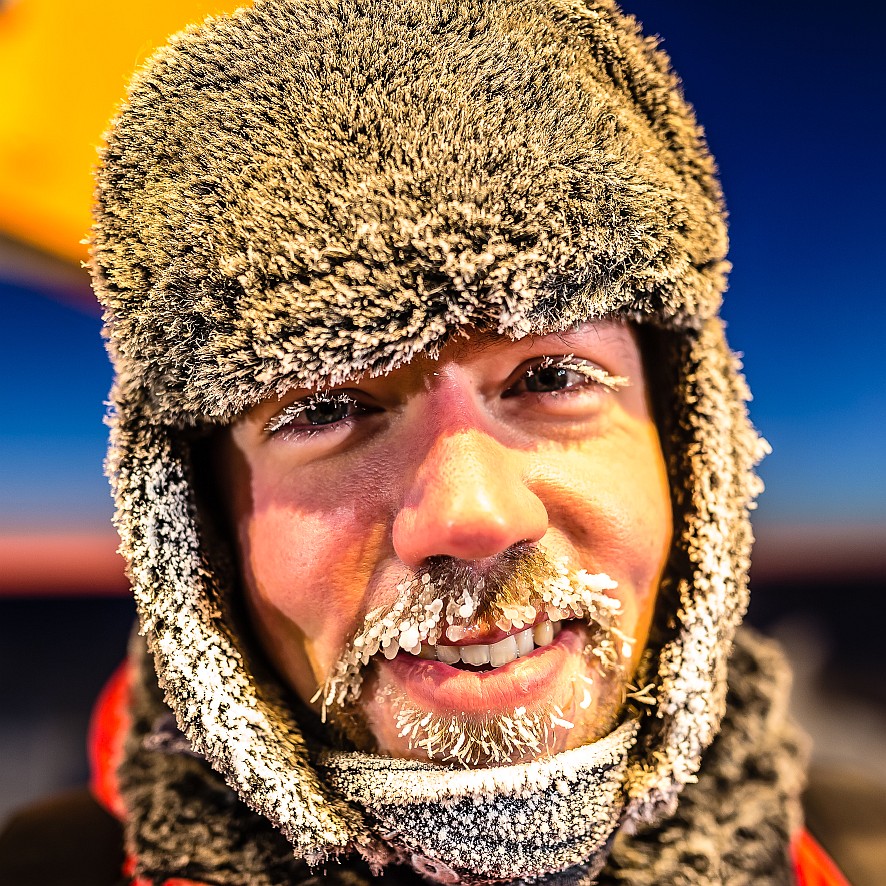
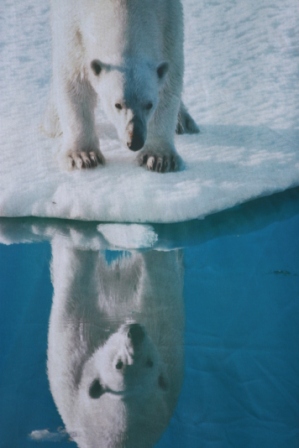

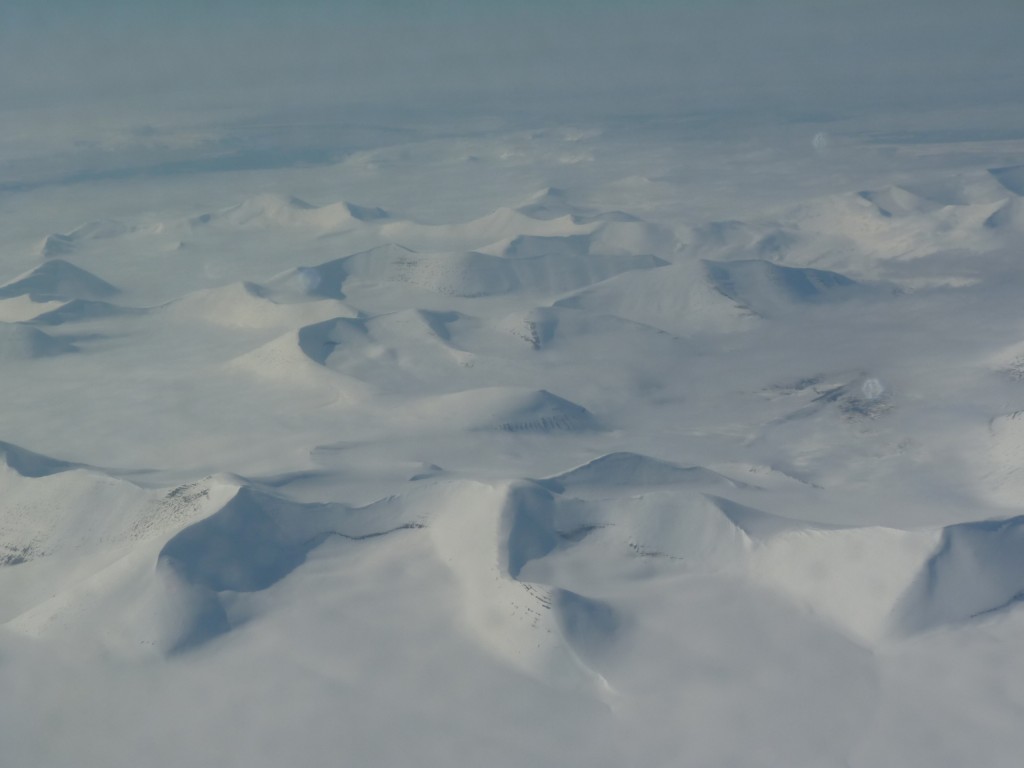
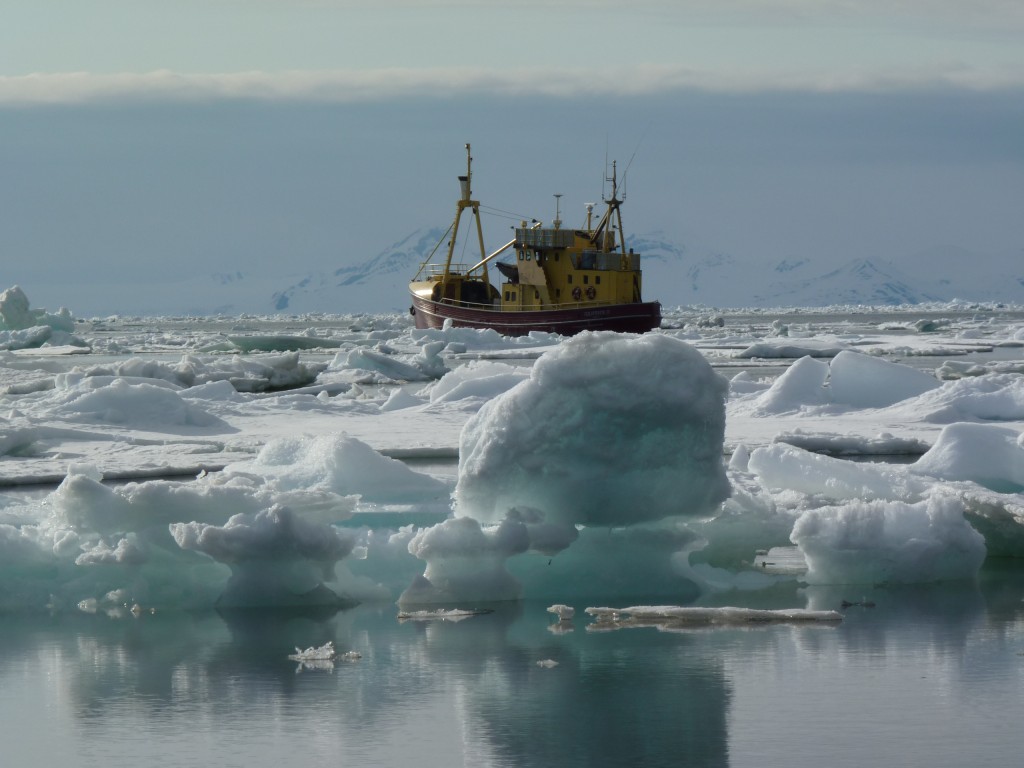
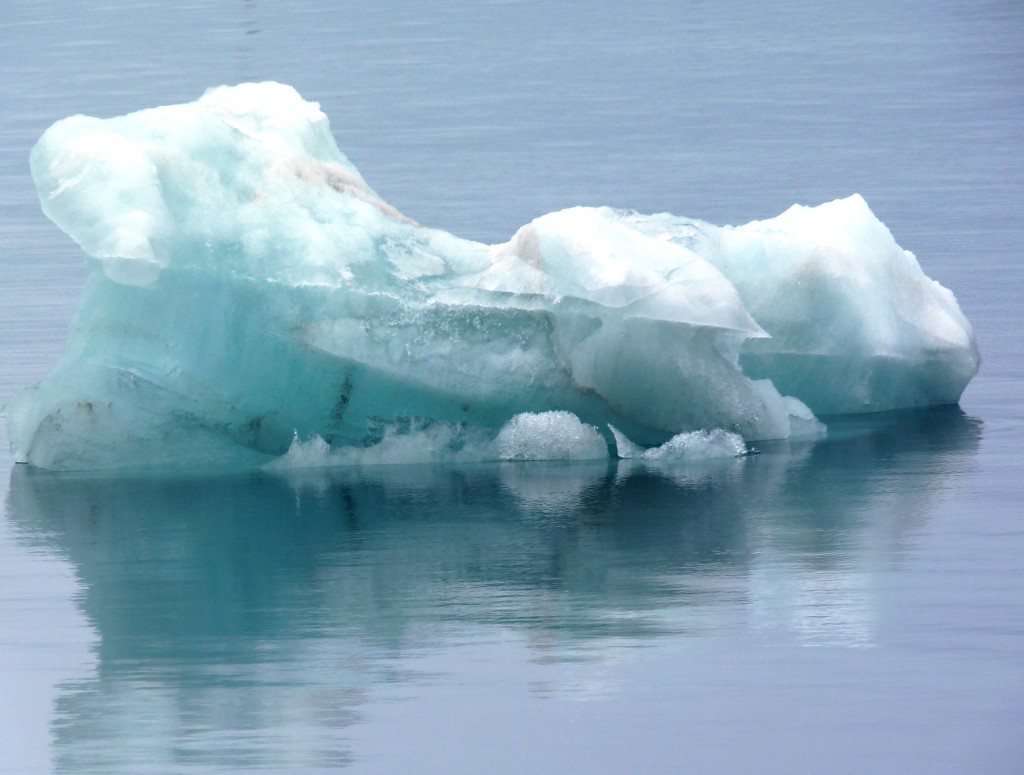
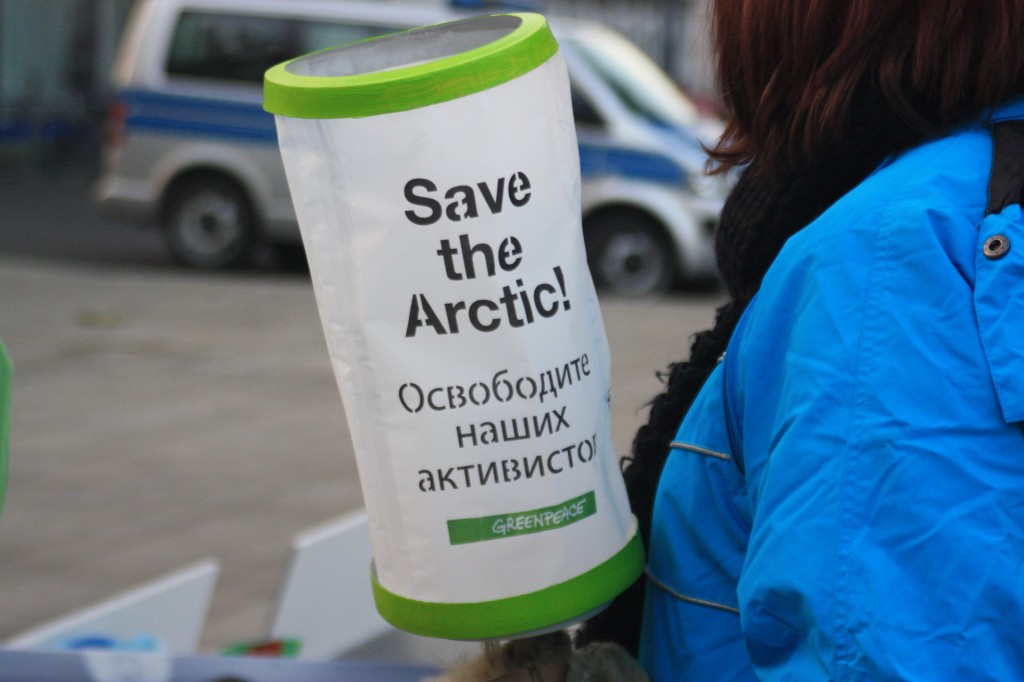
















Feedback